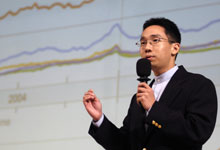請閱讀這篇文章:
Edmund Phelps’s Journey
The winner of this year’s Nobel prize for economics, Edmund Phelps, is a giant in the field. His contributions have been, and remain, so important as that they have altered traditional ways of thinking. According to the social science citations index, he ranks well among the most important economists since Adam Smith. Economists working on the macro economy, its micro foundations, exogenous and endogenous growth theory, the formation of expectations and problems of information and discrimination all refer back to Phelps.
After a brilliant secondary education, Phelps entered
As nearly always happens, Phelps’s choice of vocation came after meeting an important professor, in this case the Harvard economist James Nelson. After some hesitation, Phelps decided to pursue graduate education. Paul Samuelson admits that he agreed to do a conference at
With Ph.D. in hand, Phelps spent a year at the Rand Corporation in
By this point, Phelps had already acquired an international reputation through his work on the golden rule of capital accumulation (he was 28). This concept now appears in the toolbox of every economist, is taught in all classes on growth, and serves as a reference in all works on the macro economy.
Later, Phelps developed a long-term growth theory based on education and technical advances. However, this contribution was so far ahead of its time that the profession did not discover its importance until a quarter-century later, when theorists were developing endogenous growth theories.
Phelps was also 10 to 20 years ahead of the profession when he developed the theories of wage efficiency and inflation targeting, which are now considered to be the state of the art concerning the labour market and monetary management.
In the late
Phelps was behind the modern reworking of the macro economy – and, according to Samuelson, the micro economy, too. His research programme consisted of introducing the imperfection of information and knowledge into economic theory, which he then reformulated, giving serious consideration to agents’ expectations. In Microeconomic Foundations of Employment and Inflation Theory , a famous work that he published and to which he made three major contributions, he set the scene for what would become the greatest revolution in economic theory of the last 50 years.
It is to Phelps that we owe the theory of the natural unemployment rate – a cornerstone of modern macroeconomic theory and economic policy that Milton Friedman rediscovered a year later, albeit heuristically. Phelps was also responsible for the “island parable,” which helped explain why monetary policy can have temporary real effects as a result of imperfect information.
The bulk of Phelps’s current work consists of a new reworking of structuralist theory, in an effort to show how changes in interest rates and asset prices affect the equilibrium unemployment rate over the medium term. Phelps’s new theory provides a logical backdrop against which we can assess the consequences of fluctuations in share prices, exchange rates, and, more generally, the value of physical assets and human capital under the powerful influence of new technologies and innovation.
These are, of course, the main phenomena that economic theory struggles to explain nowadays. So it is easy to understand why Phelps still leads the way. Indeed, we can expect his new theoretical framework to become a reference point in a decade or two.
When recommending an Indian mathematician to a Harvard colleague, Ludwig Wittgenstein wrote that: “scientific geniuses generally have one great idea in their life; he has had two.” What could we say about Phelps?
Jean-Paul Fitoussi, president of the French Observatory of Economic Conditions (OFCE).

No comments:
Post a Comment